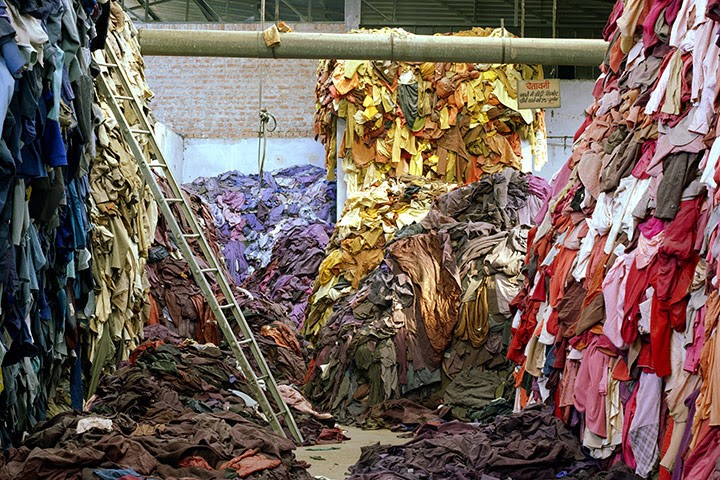The Gryphon explores the implications of the fashion industry using its power to exploit people from underprivileged backgrounds to produce ‘affordable’ clothing, as well as its detrimental impact on the environment.
The message that we are all destroying the planet through overconsumption has never rung louder than it does today. On the surface, it feels like change is in the air. Wetherspoons uses paper straws, almost every other person these days seems to be a vegetarian and more of us are finally separating our paper from our plastics. For some reason, these attitudes are not yet reflected in our approach to fashion.
The fashion industry has been growing relentlessly for decades and shows no signs of slowing down just yet. Previously, there were two fashion seasons per year. Now, there are over 52, with certain retailers releasing multiple new collections each week. Our wardrobes are bursting with cheap clothes, half of which we have no intention of wearing more than once or twice. We view our clothes as disposable without thinking twice about the damage done to the planet, communities around the world, or the people working long days in hazardous factories for barely any money.
Every single one of us needs to look through our wardrobes and face up to where our favourite brands are sourcing their clothes. If your wardrobes are anything like mine, the shameful reality is that our clothes all contain the same labels: Made in Bangladesh, Made in Indonesia, Made in Vietnam, Made in Honduras. Considering the cost of cheap clothes for those who produce them, it is incomprehensible that we can buy clothes on the high street for less than £10 and call it ‘guilt-free shopping’.
The root of the problem is the price of clothes. Western brands are increasingly selling clothes as cheaply as possible to keep up with the competitive market. The overseas factories know that if they are not able to supply their clothes at the lowest price then companies will buy elsewhere.
As a result of this, in attempts to not lose any business, sweatshops force their employees to work for the lowest possible wage. It is shocking and embarrassing that a sales assistant on the shop floor in Primark, H&M or Topshop makes in less than 3 hours the monthly wages of the person who actually makes the clothes. There is clearly no other reason for the outsourcing of clothes to developing countries other than the cheap labour and lack of regulation – surely we know this? It seems quite convenient that we choose to dissociate our clothes with the dark side of the fashion industry, but on a daily basis, we are supporting an industry that strips people of their basic human rights and we are seemingly indifferent to it.
The disgracefully low wages are not even the half of it. Time and time again, the factories that make our clothes set on fire, collapse and kill thousands of individuals. In 2012, a 7-storey factory fire in Bangladesh killed 112 people. One survivor spoke at a Washington conference urging that it was only a matter of time before the next tragedy struck. Two weeks later, Rana Plaza collapsed.
The Rana Plaza collapse of 2013 killed over 1100 of its employees. Blame for the collapse of the eight-storey building fell on the 38 people who were charged with murder in association with the collapse.
However, even The Economist argued that the Bangladeshi government was at fault due to its failure to enforce health and safety laws. The Rana Plaza factory, which has been known to supply brands such as Primark and Mango, took safety shortcuts because they knew that western retailers would move production elsewhere if they were late on delivery or missed a day of production. Retailers know this and exploit it.
Another culprit that is responsible for the horrendously unsafe working conditions is the brands, due to the amount of pressure they put on factories in the first place. Less than a month after the Rana Plaza collapse, a floor piled with material collapsed in a garment factory in Cambodia, further adding to the fashion industry’s death toll. These are not isolated incidents. They are inevitable. Clearly, our addictive consumer behaviour is not just ripping people off, it is killing them.
At the moment, very little is being done to try and resolve this massive issue. Any attempts by sweatshop employees to form trade unions are being shut down by the factories, most frequently through violence. Governments are dismissive of the problem and the brands themselves inexcusably refuse to comment. A number of companies have begun to implement ethical lines of clothing, such as H&M’s ‘Conscious’ range. In general, these programmes lack transparency, are not credible and so far, are having little effect.
Legislation is not being passed to solve this problem and so the only way to effect change is if it comes from us, the consumer. It is time to look at which companies will accept blood on their labels and call them out for it. Our attitudes need to change. We must vote with our feet and stop supporting these brands so that they feel pressured to change the way they are producing clothes. From an environmental viewpoint, the fast fashion industry has devastating effects on the planet that are impossible to sustain.
Without a doubt, we are going to see big changes in the way we consume clothes over the next decade, but whether this will be in time or not is a completely different question. Either way, a change in our attitudes cannot come soon enough.
Annabel White

